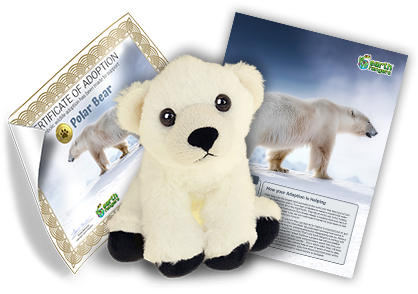When you think of Arctic animals, the first creature that comes to mind might be the powerful polar bear. These bears are the largest land carnivores (they can weigh up to 800 kg!) and they’re built for life in the frigid north. In fact, 60% of polar bears call Canada home. That’s why it’s important that we protect them. One of the biggest challenges facing polar bears is climate change. Polar bears need sea ice in order to hunt for seals, their main source of food. As the ice melts, hunting becomes more difficult for these big bears. That’s where you come in!

The life of a bear
It’s hard to imagine, but when polar bears are born, they’re not much bigger than guinea pigs. Cubs are born during the winter and remain with their mother for two years, learning how to survive in the Arctic. Luckily, they’ve got some pretty neat adaptations to keep them toasty warm: their hair is hollow, they have a thick layer of fat, and they have special under-fur that helps to insulate them against the cold. To prevent heat loss, polar bears also have small, round ears and a very small tail.

They need our help!

In the Davis Strait, high in the Arctic between Canada and Greenland, polar bears feed primarily on harp seals. That means that besides having lots of safe spaces to live and raise their cubs, polar bear habitat also needs to have enough harp seals around to feed the growing family! Unfortunately, as climate change continues to cause sea ice to melt, this habitat is becoming harder and harder to find both for polar bears and their harp seal prey – and this is a big problem.
When you adopt a polar bear, you’ll be supporting the work of University of Alberta researcher Larissa Thelin as she works on a project that will help us learn tons more about the habitat use of both polar bears and harp seals. She’ll use radio telemetry (collars that help her track the bears’ location) and satellite radio tracking to see where these animals spend most of their time. By figuring out where the seal and bear habitats overlap, she can get a better idea of what areas are most important to protect as we try to predict what might happen to the sea ice under threat as climate change continues.


Love polar bears
Thank you for posting this Earth Rangers. Climate change is real. I wish it was not real but it is. Here at Earth Rangers we are all together. We support each. We are a team. We work together. We CAN stop climate change and we WILL!
That is a great article!
I love porler bears
I wish we could send them some of our ice in the mail.
That is so cool
I feel so bad for all the animals in danger
I got the digital adoption
Hudsons bay
I love polar bears